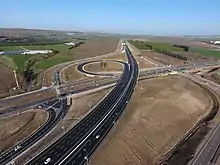Automobile city
An automobile city is a type of city planned for the usage of cars and trucks. It has a much wider horizontal extent than the walking city, spread out across many miles.[1] There is a vast increase in the amount of land devoted to parking,[1] and a much lower density in population and jobs compared to older and more compact cities.[2]

History
The advent of the automobile brought about enormous change to the designs of cities. The automobile city became the dominant form in the United States and Australia, and to a lesser extent, Canada, from the 1940s onward, as cars began to displace public transport and non-motorized modes of transportation. Land uses became split into zones, and the time to travel from place to place increased dramatically.[3] Now, the majority of United States and Australian cities are part of the automobile-city tradition.[2]
Features
The automobile city is a modern type of city that includes locations such as Houston, Phoenix, Perth, and Brisbane. Since people can commute from the suburbs to the inner city, the central city high-rise office block is a trait mainly specific to the automobile city.[2]
The city design has been criticized for leading to urban sprawl, decreased use of public transportation, increased air pollution due to the vast amounts of cars, and a decreased sense of place due to the ease of long-distance car travel.[4] In cities with little planning to control the use of cars, such as Bangkok and Kuala Lampur in Asia, formerly high-density walking cities have been transformed into automobile cities due to lack of facilities, causing high numbers of transport deaths, especially amongst non-motorized mode users and motorcyclists.[3]
See also
References
- Rybczynski, Witold (2014). City Life. Scribner. ISBN 978-1-4767-3734-8. OCLC 891696904.
- Newman, Peter, 1945– (1989). Cities and automobile dependence : a sourcebook. Kenworthy, Jeffrey R., 1955–. Aldershot, Hants., England: Gower Technical. ISBN 0-566-07040-5. OCLC 20132931.CS1 maint: multiple names: authors list (link)
- Schiller, Preston L. (2010). An introduction to sustainable transportation : policy, planning and implementation. Bruun, Eric Christian., Kenworthy, Jeffrey R., 1955–. London: Earthscan. pp. 27–28. ISBN 978-1-84977-502-1. OCLC 659549750.
- Marshall, Alex (2010). How Cities Work: Suburbs, Sprawl, and the Roads Not Taken. University of Texas Press. pp. 44–45. ISBN 0292792433.